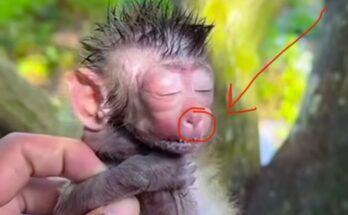In a heartbreaking incident that highlights the growing conflict between wildlife and human infrastructure, a baby monkey was electrocuted to death after coming into contact with a live electrical wire. The tragedy occurred near a residential area where power cables run dangerously close to trees — a common sight in many parts of the world where urban expansion encroaches on natural habitats.
According to witnesses, the young monkey had been playing energetically with its troop in the area. Unaware of the danger, it reportedly grabbed onto a dangling electric wire, mistaking it for a branch or a toy. Within moments, it was electrocuted, and the lifeless body fell to the ground. Locals rushed to the scene, but the animal had already succumbed to its injuries.
The incident sparked sorrow and frustration among residents and animal lovers alike, who blamed unsafe electrical installations and poor maintenance for the tragedy. “We often see monkeys climbing power poles and jumping across wires,” said one eyewitness. “This could have been prevented if the authorities took proper measures to insulate or cover exposed cables.”
Experts note that such incidents are becoming increasingly common as wildlife habitats shrink due to deforestation and rapid urban development. Monkeys, known for their curiosity and intelligence, often venture into human settlements in search of food or shelter. Unfortunately, their inquisitive nature sometimes leads them into dangerous situations — from electrocution to road accidents.
Wildlife conservationists have called for urgent action to protect both animals and humans from these preventable deaths. “Simple steps like insulating overhead wires, trimming branches near power lines, and conducting regular inspections can save countless lives,” said a local environmental activist. “It’s a shared responsibility — the government, utility companies, and the public must work together to make urban areas safer for wildlife.”
In many countries, wildlife rescue organizations are advocating for “coexistence zones” — areas where infrastructure is designed with animal safety in mind. For example, some regions have successfully implemented insulated electric lines and animal corridors that allow safe movement between habitats. These small but effective measures have dramatically reduced such tragic incidents.
The death of the baby monkey serves as a painful reminder of the fragile balance between human progress and nature. It also raises important questions about accountability and awareness. How many more innocent creatures must die before meaningful change occurs?
For the local community, the loss has become a call to action. Residents have begun petitioning local authorities to repair exposed wires and collaborate with animal welfare groups to prevent future accidents. As one resident poignantly stated, “We build cities for ourselves, but we must remember that animals also share this planet. Their safety is a reflection of our humanity.”
While the tiny life lost cannot be brought back, its story may inspire a broader effort to ensure that such tragedies do not repeat. Protecting wildlife from man-made dangers is not just an act of compassion — it is a duty we owe to the natural world that sustains us all.



